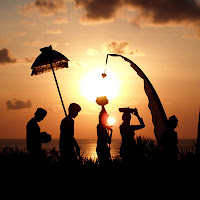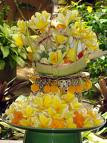Galungan and Kuningan Holiday in Bali
There are many holiday in Bali. Bali has many traditional holidays. Balinese calendars, with illustrations for each day indicating what activities that day are auspicious for, are popular souvenirs. Apart from the everyday Western calendar, the Balinese also use two local calendars, the saka and the wuku calendar. The wuku calendar is used to determine festival dates.
activities that day are auspicious for, are popular souvenirs. Apart from the everyday Western calendar, the Balinese also use two local calendars, the saka and the wuku calendar. The wuku calendar is used to determine festival dates.
The calendar uses 10 different weeks, each fro m one to 10 days and all running simultaneously. One of feast day that highly anticipated by the Hindu community of Bali is Galungan and Kuningan. Both of these holidays is a series within 10 days.
m one to 10 days and all running simultaneously. One of feast day that highly anticipated by the Hindu community of Bali is Galungan and Kuningan. Both of these holidays is a series within 10 days.
Galungan and Kuningan is a great day in Bali. Balinese Hindu community celebrated the victory of Dharma (goodness) against Adharma (evil). Galungan holiday is one of the unique tradition in Bali, very happy, and uniting families to meet in a wonderful celebration.

 omes. They must be suitably entertained and welcomed, and prayers and offerings must be made for them. Those families who have ancestors that have not yet been cremated, but are still buried in the village cemetery, must make offerings at the graves.
omes. They must be suitably entertained and welcomed, and prayers and offerings must be made for them. Those families who have ancestors that have not yet been cremated, but are still buried in the village cemetery, must make offerings at the graves.
On Wednesday, the day of Galungan, one will find that most Balinese will try to return to their own ancestral home at some stage during the day, even if they work in another part of the island. This is a very special day for families, where offerings are made to God and to the family ancestors who have come back to rest at this time in their family temple. As well as the family temple, visits are made to the village temple with offerings as well, and to the homes of other families who may have helped the family in some way over the past six months.
The day after Galungan is a time for a holiday, visiting friends, maybe taking the opportunity to head for the mountains for a picnic. Everyone is still seen to be in their ‘Sunday best’ as they take to the streets to enjoy the festive spirit that Galungan bring to Bali.
 activities that day are auspicious for, are popular souvenirs. Apart from the everyday Western calendar, the Balinese also use two local calendars, the saka and the wuku calendar. The wuku calendar is used to determine festival dates.
activities that day are auspicious for, are popular souvenirs. Apart from the everyday Western calendar, the Balinese also use two local calendars, the saka and the wuku calendar. The wuku calendar is used to determine festival dates. The calendar uses 10 different weeks, each fro
 m one to 10 days and all running simultaneously. One of feast day that highly anticipated by the Hindu community of Bali is Galungan and Kuningan. Both of these holidays is a series within 10 days.
m one to 10 days and all running simultaneously. One of feast day that highly anticipated by the Hindu community of Bali is Galungan and Kuningan. Both of these holidays is a series within 10 days. Galungan and Kuningan is a great day in Bali. Balinese Hindu community celebrated the victory of Dharma (goodness) against Adharma (evil). Galungan holiday is one of the unique tradition in Bali, very happy, and uniting families to meet in a wonderful celebration.

During this ten day period all the gods, including the supreme deity Sang Hyang Widi, come down to earth for the festivities. Barongs prance from temple to temple and village to village.
During the Galungan period the deified ancestors of the family descend to their former h
 omes. They must be suitably entertained and welcomed, and prayers and offerings must be made for them. Those families who have ancestors that have not yet been cremated, but are still buried in the village cemetery, must make offerings at the graves.
omes. They must be suitably entertained and welcomed, and prayers and offerings must be made for them. Those families who have ancestors that have not yet been cremated, but are still buried in the village cemetery, must make offerings at the graves.
Although Galungan falls on a Wednesday, most Balinese will begin their Ga lungan ‘holiday’ the day before, where the family is seen to be busily preparing offerings and cooking for the next day.
lungan ‘holiday’ the day before, where the family is seen to be busily preparing offerings and cooking for the next day.
 lungan ‘holiday’ the day before, where the family is seen to be busily preparing offerings and cooking for the next day.
lungan ‘holiday’ the day before, where the family is seen to be busily preparing offerings and cooking for the next day.
While the women of the household have been busy for days before creating beautifully woven ‘banten‘ (offerings made from young coconut fronds), the men of our village usually wake up well before dawn to join with their neighbours to slaughter a pig unlucky enough to be chosen to help celebrate this occasion.
Then the finely diced pork is mashed to a pulp with a grinding stone, and moulded onto sate sticks that have been already prepared by  whittling small sticks of bamboo.
whittling small sticks of bamboo.
 whittling small sticks of bamboo.
whittling small sticks of bamboo.
Chickens may also be chosen from the collection of free-range chickens that roam around the house compound. Delicate combinations of various vegetables, herbs and spices are also prep ared by the men to make up a selection of ‘lawar‘dishes.
ared by the men to make up a selection of ‘lawar‘dishes.
 ared by the men to make up a selection of ‘lawar‘dishes.
ared by the men to make up a selection of ‘lawar‘dishes.
While much of this cooking is for use in the offerings to be made at the family temple, by mid-morning, once all the cooking is done, it is time for the first of a series of satisfying feasts from what has been prepared. While the women continue to be kept busy with the preparations of the many offerings to be made at the family temple on the day of Galungan, the men also have anot her job to do this day, once the cooking is finished. A long bamboo pole, or ‘penjor‘, is made to decorate the entrance to the family compound. By late Tuesday afternoon all over Bali the visitor can see these decorative poles creating a very festive atmosphere in the street.
her job to do this day, once the cooking is finished. A long bamboo pole, or ‘penjor‘, is made to decorate the entrance to the family compound. By late Tuesday afternoon all over Bali the visitor can see these decorative poles creating a very festive atmosphere in the street.
 her job to do this day, once the cooking is finished. A long bamboo pole, or ‘penjor‘, is made to decorate the entrance to the family compound. By late Tuesday afternoon all over Bali the visitor can see these decorative poles creating a very festive atmosphere in the street.
her job to do this day, once the cooking is finished. A long bamboo pole, or ‘penjor‘, is made to decorate the entrance to the family compound. By late Tuesday afternoon all over Bali the visitor can see these decorative poles creating a very festive atmosphere in the street. |
| Penjor. |

The day after Galungan is a time for a holiday, visiting friends, maybe taking the opportunity to head for the mountains for a picnic. Everyone is still seen to be in their ‘Sunday best’ as they take to the streets to enjoy the festive spirit that Galungan bring to Bali.
The last and most important day of the ten day festival is called Kuningan. Hindu Saka calendar is a lunar cycle that more closely follows our own year in terms of the length of the year.


Comments
Post a Comment